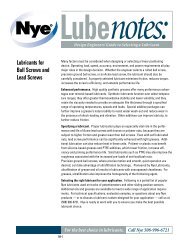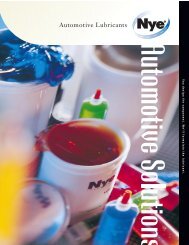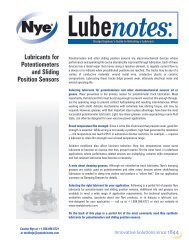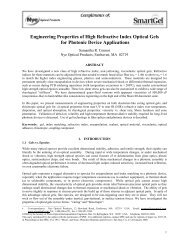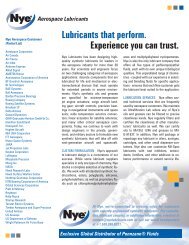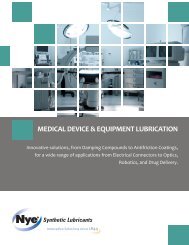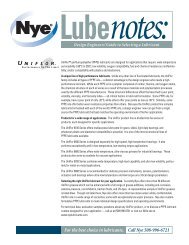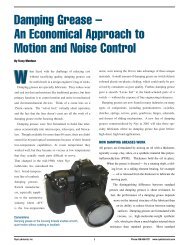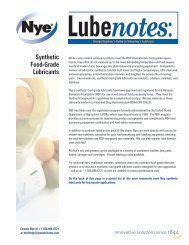Optical Gels: - Nye Lubricants, Inc.
Optical Gels: - Nye Lubricants, Inc.
Optical Gels: - Nye Lubricants, Inc.
Create successful ePaper yourself
Turn your PDF publications into a flip-book with our unique Google optimized e-Paper software.
Using an <strong>Optical</strong> Gel in a Photonic Device<br />
Relative Motion between lens<br />
and photodetector occurs during<br />
soldering, or mechanical<br />
shock and vibration.<br />
Outer<br />
Housing<br />
•<br />
<strong>Optical</strong> gel matches<br />
index from lens to coating.<br />
Mechanical pliability<br />
prevents delamination.<br />
Index of refraction =1.51<br />
•<br />
<strong>Inc</strong>ident<br />
Light Signal<br />
•<br />
•<br />
•<br />
Photodiode chip<br />
detects light signal<br />
•<br />
Surface mount pads are exposed<br />
to >200°C when soldered to a PCB.<br />
Gel must withstand this heat without yellowing.<br />
Plastic (PMMA) lens<br />
seals and protects photodiode<br />
sensor element<br />
Index of refraction =1.49<br />
Proprietary polymer<br />
coating protects<br />
photodiode chip.<br />
Index of refraction =1.53<br />
Using an <strong>Optical</strong> Gel in a Photodetector<br />
The lens in this example is an engineering plastic with an index of refraction of 1.49. The photodiode<br />
element has an outer polymer coating with an index of refraction of 1.53. A curing optical<br />
gel is chosen to fill the space between the lens and the photodiode. In order to optimize<br />
light transmission, a gel with an index equal to the geometric mean of the two adjoining materials<br />
is ideal, or, mathematically,<br />
nGEL= {1.49 x 1.53 }1/2 = 1.51.<br />
The designers of this device also expect large dimensional excursions when this component is<br />
subjected to wave-soldering temperatures on a printed circuit board. In order to prevent delamination<br />
or damage to wire bonds, they specify the gel for ample pliability, in this case, a Shore<br />
00 hardness of 15, like a slightly rigid version of gelatin pudding.<br />
splice.” This was a tricky process that required extensive technician<br />
training and costly “fusion splicer” gear. Enter the<br />
“mechanical splice,” which skirted the cost and complexity<br />
issues encountered with fusion splices. Cleaved fibers were<br />
inserted into either end of the mechanical splice until they<br />
touched in the center of the housing. To minimize reflection at<br />
the unavoidable air gap between fiber end faces, the gap was<br />
filled with an optical fluid whose refractive index matched the<br />
silica glass. Since the amount of signal reflection depends on<br />
the difference in refractive indices,<br />
displacing air in the gap with the<br />
index-matching optical fluid allowed<br />
the light to flow from one cable to the<br />
other with minimal reflection.<br />
However, because fluids are prone to<br />
leakage, evaporation, and mechanical<br />
instability, their effectiveness was<br />
compromised. They were soon<br />
replaced with optical gels — crystalclear,<br />
stable, index-matching, synthetic<br />
gels with wide-temperature<br />
serviceability and a 30-year service<br />
life, which are now the industry standard<br />
in mechanical optical splices.<br />
GELS OR EPOXIES<br />
Today, index-matching gels are finding<br />
their way into a growing number<br />
of electro-optic devices, including<br />
optical sensors, photodiodes, laser<br />
packaging, medical instruments, and<br />
flat panel displays. Sometimes they<br />
replace more traditional optical epoxies.<br />
While many optical epoxies provide<br />
excellent dimensional stability,<br />
adhesion, and tensile strength, their<br />
rigidity can literally be the undoing of<br />
an optical device. <strong>Optical</strong> epoxies<br />
can trap stresses in an optical assembly.<br />
At low stress levels, birefringence can be induced in nearby<br />
optical glasses and plastics, degrading performance of polarization-sensitive<br />
designs. Over wide service temperature<br />
ranges or under thermal shock or excessive vibration, epoxies<br />
can induce actual damage by fracturing or delaminating from<br />
glass or plastic. In a photonic assembly, such fractures often<br />
decrease light output, reduce sensitivity, increase reflection, or<br />
even cause catastrophic electronic failure. Under similar operating<br />
conditions, optical gels present a rugged alternative to<br />
<strong>Nye</strong> <strong>Lubricants</strong>, <strong>Inc</strong>. 2<br />
Phone 508-996-6721 www.nyelubricants.com



